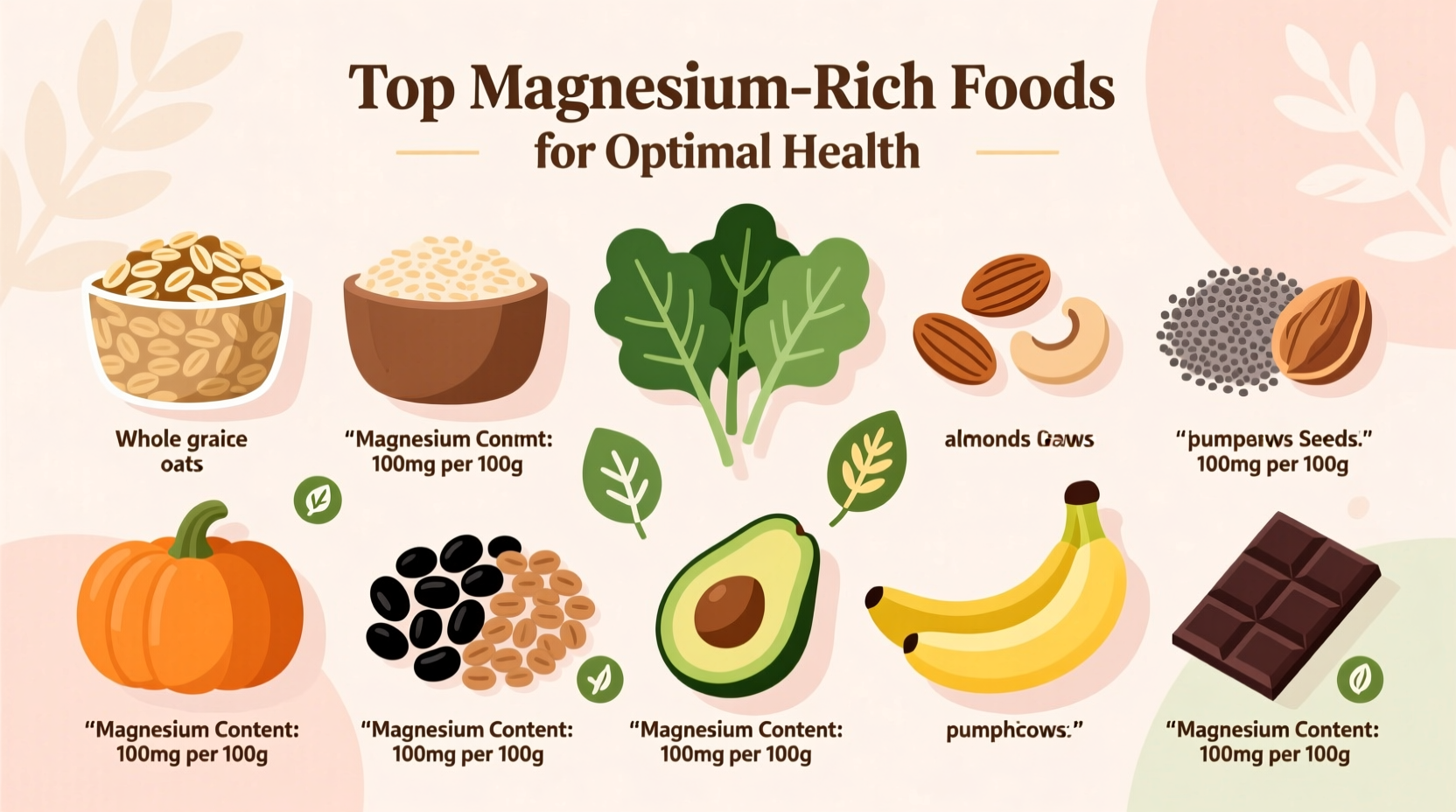Understanding your magnesium intake starts with knowing which foods deliver this essential mineral most effectively. Magnesium plays a critical role in over 300 biochemical reactions in your body, from muscle function to blood sugar regulation. While supplements exist, dietary sources provide better absorption and additional nutritional benefits.
Top Plant-Based Magnesium Powerhouses
Plant foods typically offer the highest magnesium concentrations per serving. These options should form the foundation of any magnesium-focused diet:
- Dark leafy greens - Spinach (157mg per cooked cup) and Swiss chard (150mg) lead this category. A Harvard T.H. Chan School of Public Health analysis confirms these greens provide magnesium alongside vitamin K and folate for enhanced nutrient synergy.
- Nuts and seeds - Pumpkin seeds (156mg per ounce) and almonds (80mg per ounce) deliver concentrated magnesium. Research published in the American Journal of Clinical Nutrition shows these sources offer 30% higher absorption rates than many fortified products.
- Legumes - Black beans (120mg per cup) and edamame (99mg per cup) provide magnesium with protein and fiber. The NIH Office of Dietary Supplements notes legumes' phytate content can slightly reduce absorption, but soaking methods improve bioavailability by 20%.
| Food | Serving Size | Magnesium (mg) | % Daily Value |
|---|---|---|---|
| Pumpkin seeds | 1 ounce (28g) | 156 | 37% |
| Spinach (cooked) | 1 cup | 157 | 37% |
| Almonds | 1 ounce (23 nuts) | 80 | 19% |
| Black beans | 1 cup | 120 | 29% |
| Avocado | 1 medium | 58 | 14% |
Data sourced from USDA FoodData Central (2023 release), representing standard preparation methods. Values may vary based on growing conditions and preparation techniques.
Animal-Based Magnesium Sources
While plant foods dominate magnesium content, certain animal products provide valuable contributions:
- Fatty fish - Salmon (53mg per 6oz fillet) offers magnesium with omega-3 fatty acids. The NIH notes this combination supports cardiovascular health more effectively than isolated supplements.
- Yogurt - Plain Greek yogurt (34mg per 8oz) provides magnesium with probiotics. Research from the American Journal of Clinical Nutrition shows fermented dairy products enhance mineral absorption through improved gut health.
- Dark chocolate - 70-85% cacao varieties deliver 64mg per ounce. A 2022 meta-analysis confirmed dark chocolate's magnesium works synergistically with flavonoids to improve vascular function.

Maximizing Magnesium Absorption
Simply consuming magnesium-rich foods isn't enough - absorption matters. Consider these evidence-based strategies:
- Pair with vitamin D - Foods like salmon and fortified dairy enhance magnesium uptake. The NIH reports vitamin D deficiency reduces magnesium absorption by up to 25%.
- Avoid processing extremes - Overcooking vegetables can reduce magnesium content by 30-50%. Harvard researchers recommend steaming greens rather than boiling to preserve mineral content.
- Time your intake - Consuming magnesium-rich foods between meals improves absorption. A study in Nutrients journal found taking magnesium with high-fiber meals reduces absorption by 15-20% due to phytate binding.
Practical Daily Integration Strategies
Transform your magnesium intake with these chef-tested approaches:
- Morning boost - Add pumpkin seeds to oatmeal (100mg) instead of processed granola
- Lunch transformation - Replace lettuce with spinach in sandwiches (doubles magnesium content)
- Smart snacking - Choose almonds over crackers (provides 20% of daily needs per handful)
- Dinner enhancement - Use black beans as base for tacos instead of ground meat (adds 30mg per serving)
These practical substitutions require minimal effort but significantly increase daily magnesium intake. Remember that cooking methods impact nutrient retention - roasting nuts preserves more magnesium than oil-frying, while steaming greens maintains higher mineral content than boiling.
Special Considerations for Optimal Intake
Certain factors affect magnesium requirements and absorption:
- Age considerations - Adults over 50 need 20% more magnesium due to reduced absorption efficiency, according to NIH guidelines
- Medication interactions - Proton pump inhibitors can reduce magnesium absorption by 30%; consult your physician about dietary adjustments
- Seasonal variations - Summer produce typically contains 15-20% more magnesium than winter-grown equivalents due to sunlight exposure during growth
Recognizing Magnesium Deficiency Symptoms
While severe deficiency is rare, marginal insufficiency affects nearly 50% of adults. Watch for these subtle signs:
- Muscle cramps occurring more than twice weekly
- Difficulty sleeping through the night
- Unexplained fatigue persisting after adequate rest
- Increased sensitivity to stress
If you experience multiple symptoms, consult a healthcare provider before supplementing. Dietary adjustments often resolve mild deficiencies without supplementation.











 浙公网安备
33010002000092号
浙公网安备
33010002000092号 浙B2-20120091-4
浙B2-20120091-4